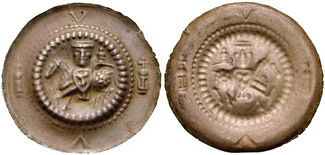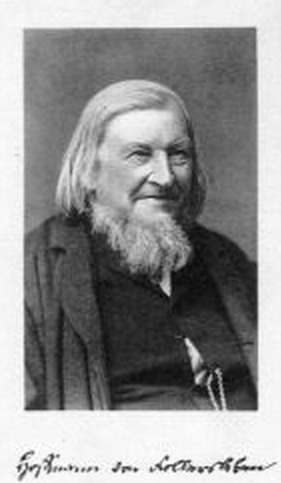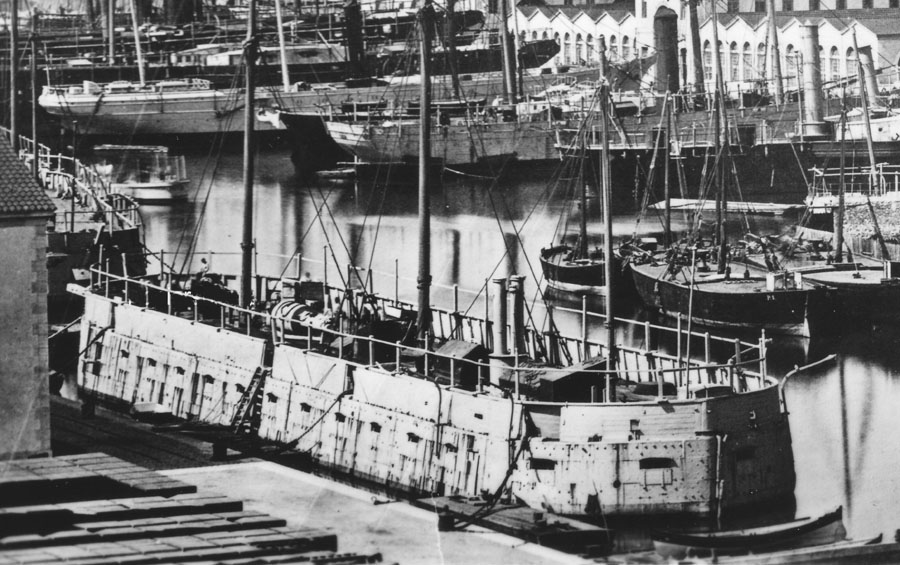|
Mushroom Cloud
A mushroom cloud is a distinctive mushroom-shaped flammagenitus cloud of debris, smoke and usually condensed water vapor resulting from a large explosion. The effect is most commonly associated with a nuclear explosion, but any sufficiently energetic detonation or deflagration will produce the same effect. They can be caused by powerful conventional weapons, like thermobaric weapons, including the ATBIP and GBU-43/B Massive Ordnance Air Blast. Some volcanic eruptions and impact events can produce natural mushroom clouds. Mushroom clouds result from the sudden formation of a large volume of lower-density gases at any altitude, causing a Rayleigh–Taylor instability. The buoyant mass of gas rises rapidly, resulting in turbulent vortices curling downward around its edges, forming a temporary vortex ring that draws up a central column, possibly with smoke, debris, condensed water vapor, or a combination of these, to form the "mushroom stem". The mass of gas plus entrained moist ai ... [...More Info...] [...Related Items...] OR: [Wikipedia] [Google] [Baidu] |
Vortices
In fluid dynamics, a vortex ( : vortices or vortexes) is a region in a fluid in which the flow revolves around an axis line, which may be straight or curved. Vortices form in stirred fluids, and may be observed in smoke rings, whirlpools in the wake of a boat, and the winds surrounding a tropical cyclone, tornado or dust devil. Vortices are a major component of turbulent flow. The distribution of velocity, vorticity (the curl of the flow velocity), as well as the concept of circulation are used to characterise vortices. In most vortices, the fluid flow velocity is greatest next to its axis and decreases in inverse proportion to the distance from the axis. In the absence of external forces, viscous friction within the fluid tends to organise the flow into a collection of irrotational vortices, possibly superimposed to larger-scale flows, including larger-scale vortices. Once formed, vortices can move, stretch, twist, and interact in complex ways. A moving vortex carries so ... [...More Info...] [...Related Items...] OR: [Wikipedia] [Google] [Baidu] |
Olaf Stapledon
William Olaf Stapledon (10 May 1886 – 6 September 1950) – known as Olaf Stapledon – was a British philosopher and author of science fiction.Andy Sawyer, " illiamOlaf Stapledon (1886-1950)", in Bould, Mark, et al, eds. ''Fifty Key Figures in Science Fiction''. New York: Routledge, 2010. (pp. 205–210) .John Kinnaird, "Stapledon,(William) Olaf" in Curtis C. Smith, ''Twentieth-Century Science-Fiction Writers''. Chicago, St. James, 1986. (pp. 693–6). In 2014, he was inducted into the Science Fiction and Fantasy Hall of Fame. Life Stapledon was born in Seacombe, Wallasey, on the Wirral Peninsula in Cheshire, the only son of William Clibbett Stapledon and Emmeline Miller. The first six years of his life were spent with his parents at Port Said, Egypt. He was educated at Abbotsholme School and Balliol College, Oxford, where he acquired a BA degree in Modern History (Second Class) in 1909, promoted to an MA degree in 1913. After a brief stint as a teacher at Manchester G ... [...More Info...] [...Related Items...] OR: [Wikipedia] [Google] [Baidu] |
Halifax Explosion
On the morning of 6 December 1917, the French cargo ship collided with the Norwegian vessel in the waters of Halifax, Nova Scotia, Canada. The ''Mont-Blanc'', laden with high explosives, caught fire and exploded, devastating the Richmond district of Halifax. 1,782 people were killed, largely in Halifax and Dartmouth, by the blast, debris, fires, or collapsed buildings, and an estimated 9,000 others were injured. The blast was the largest human-made explosion at the time, releasing the equivalent energy of roughly . ''Mont-Blanc'' was under orders from the French government to carry her cargo from New York City via Halifax to Bordeaux, France. At roughly 8:45 am, she collided at low speed, approximately one knot (), with the unladen ''Imo'', chartered by the Commission for Relief in Belgium to pick up a cargo of relief supplies in New York. On the ''Mont-Blanc'', the impact damaged benzol barrels stored on deck, leaking vapours which were ignited by sparks from the ... [...More Info...] [...Related Items...] OR: [Wikipedia] [Google] [Baidu] |
Gotha
Gotha () is the fifth-largest city in Thuringia, Germany, west of Erfurt and east of Eisenach with a population of 44,000. The city is the capital of the district of Gotha and was also a residence of the Ernestine Wettins from 1640 until the end of monarchy in Germany in 1918. The House of Saxe-Coburg and Gotha originating here spawned many European rulers, including the royal houses of the United Kingdom, Belgium, Portugal (until 1910) and Bulgaria (until 1946). In the Middle Ages, Gotha was a rich trading town on the trade route ''Via Regia'' and between 1650 and 1850, Gotha saw a cultural heyday as a centre of sciences and arts, fostered by the dukes of Saxe-Gotha. The first duke, Ernest the Pious, was famous for his wise rule. In the 18th century, the ''Almanach de Gotha'' was first published in the city. The publisher Justus Perthes and the encyclopedist Joseph Meyer made Gotha a leading centre of German publishing around 1800. In the early 19th century, Gotha was a bi ... [...More Info...] [...Related Items...] OR: [Wikipedia] [Google] [Baidu] |
1798 Veith - Physikalischer Kinderfreund
Events January–June * January – Eli Whitney contracts with the U.S. federal government for 10,000 muskets, which he produces with interchangeable parts. * January 4 – Constantine Hangerli enters Bucharest, as Prince of Wallachia. * January 22 – A coup d'état is staged in the Netherlands (Batavian Republic). Unitarian Democrat Pieter Vreede ends the power of the parliament (with a conservative-moderate majority). * February 10 – The Pope is taken captive, and the Papacy is removed from power, by French General Louis-Alexandre Berthier. * February 15 – U.S. Representative Roger Griswold (Fed-CT) beats Congressman Matthew Lyon (Dem-Rep-VT) with a cane after the House declines to censure Lyon earlier spitting in Griswold's face; the House declines to discipline either man.''Harper's Encyclopaedia of United States History from 458 A. D. to 1909'', ed. by Benson John Lossing and, Woodrow Wilson (Harper & Brothers, 1910) p171 * March – th ... [...More Info...] [...Related Items...] OR: [Wikipedia] [Google] [Baidu] |
Heated Shot
Heated shot or hot shot is round shot that is heated before firing from muzzle-loading cannons, for the purpose of setting fire to enemy warships, buildings, or equipment. The use of heated shot dates back centuries; it was a powerful weapon against wooden warships, where fire was always a hazard. However, it was rendered obsolete in the mid-19th century when vessels armored with iron replaced wooden warships in the world's navies. Also at around the same time, the replacement of solid-iron shot with exploding shells gave artillery a far more destructive projectile that could be fired immediately without preparation.Roberts, 1863, pg. 107 The use of heated shot was mainly confined to shore batteries and forts, due to the need for a special furnace to heat the shot, and their use from a ship was in fact against Royal Navy regulations because they were so dangerous, although the American ship USS ''Constitution'' had a shot furnace installed for hot shot to be fired from her carron ... [...More Info...] [...Related Items...] OR: [Wikipedia] [Google] [Baidu] |
Floating Battery
A floating battery is a kind of armed watercraft, often improvised or experimental, which carries heavy armament but has few other qualities as a warship. History Use of timber rafts loaded with cannon by Danish defenders of Copenhagen against bomb ketches of a combined British-Dutch-Swedish fleet is attested by Nathaniel Uring in 1700. An early appearance was in 1782 at the Great Siege of Gibraltar, and its invention and usage is attributed to Spanish Lieutenant General Antonio Barceló. A purpose-built floating battery was ''Flådebatteri No. 1'', designed by Chief Engineer Henrik Gerner in 1787; it was long, wide and armed with 24 guns, and was used during the 1801 Battle of Copenhagen under the command of Peter Willemoes. The British made limited use of floating batteries during the French Revolutionary and Napoleonic Wars, with the two-vessel and -class floating batteries, and some individual vessels such as . The most notable floating batteries were built o ... [...More Info...] [...Related Items...] OR: [Wikipedia] [Google] [Baidu] |
Great Siege Of Gibraltar
The Great Siege of Gibraltar was an unsuccessful attempt by Spain and France to capture Gibraltar from the British during the War of the American Revolution. It was the largest battle in the war by number of combatants. The American war had ended with the British defeat at Yorktown in October 1781, but the Bourbon defeat in their great final assault on Gibraltar would not come until September 1782. The siege was suspended in February 1783 at the beginning of peace talks with the British. On 16 June 1779, Spain entered the war on the side of France and as co-belligerents of the revolutionary United Colonies—the British base at Gibraltar was Spain's primary war aim. The vulnerable Gibraltar garrison under George Augustus Eliott was blockaded from June 1779 to February 1783, initially by the Spanish alone, led by Martín Álvarez de Sotomayor. The blockade proved to be a failure because two relief convoys entered unmolested—the first under Admiral George Rodney in 1780 and th ... [...More Info...] [...Related Items...] OR: [Wikipedia] [Google] [Baidu] |
Aquatint
Aquatint is an intaglio printmaking technique, a variant of etching that produces areas of tone rather than lines. For this reason it has mostly been used in conjunction with etching, to give both lines and shaded tone. It has also been used historically to print in colour, both by printing with multiple plates in different colours, and by making monochrome prints that were then hand-coloured with watercolour. It has been in regular use since the later 18th century, and was most widely used between about 1770 and 1830, when it was used both for artistic prints and decorative ones. After about 1830 it lost ground to lithography and other techniques. There have been periodic revivals among artists since then. An aquatint plate wears out relatively quickly, and is less easily reworked than other intaglio plates. Many of Goya's plates were reprinted too often posthumously, giving very poor impressions. Among the most famous prints using the aquatint technique are the major serie ... [...More Info...] [...Related Items...] OR: [Wikipedia] [Google] [Baidu] |
Atomic Era
The Atomic Age, also known as the Atomic Era, is the period of history following the detonation of the first nuclear weapon, The Gadget at the ''Trinity'' test in New Mexico, on July 16, 1945, during World War II. Although nuclear chain reactions had been hypothesized in 1933 and the first artificial self-sustaining nuclear chain reaction (Chicago Pile-1) had taken place in December 1942, the Trinity test and the ensuing bombings of Hiroshima and Nagasaki that ended World War II represented the first large-scale use of nuclear technology and ushered in profound changes in sociopolitical thinking and the course of technological development. While atomic power was promoted for a time as the epitome of progress and modernity, entering into the nuclear power era also entailed frightful implications of nuclear warfare, the Cold War, mutual assured destruction, nuclear proliferation, the risk of nuclear disaster (potentially as extreme as anthropogenic global nuclear winter), as well a ... [...More Info...] [...Related Items...] OR: [Wikipedia] [Google] [Baidu] |
Vue Du Siege De Gibraltar Et Explosion Des Batteries Flottantes 1782
Vue or VUE may refer to: Places * Vue, Loire-Atlantique, a commune in France * The Vue, a skyscraper in Charlotte, North Carolina Arts, entertainment and media * Vue (band), a rock and roll band from San Francisco, California * Vue Cinemas, a cinema company in the United Kingdom * ''Vue Weekly'', an alternative newspaper in Edmonton, Canada * PlayStation Vue, a former American streaming service from Sony Television stations * KVUE, the ABC TV affiliate for Austin, Texas, US * WVUE (Wilmington, Delaware), a defunct TV station in Wilmington, Delaware, US * WVUE-DT, the Fox TV affiliate for New Orleans, Louisiana, US Brands and enterprises * Pearson VUE, an electronic testing company * Saturn Vue, a sport utility vehicle * Vue International, a multinational cinema holding company based in the UK * Vue Pack, single-serve coffee system by Keurig * Vue.ai, A Madstreetden brand based in the USA Science and technology * Villitis of unknown etiology, a placental injury Software * E-on V ... [...More Info...] [...Related Items...] OR: [Wikipedia] [Google] [Baidu] |









